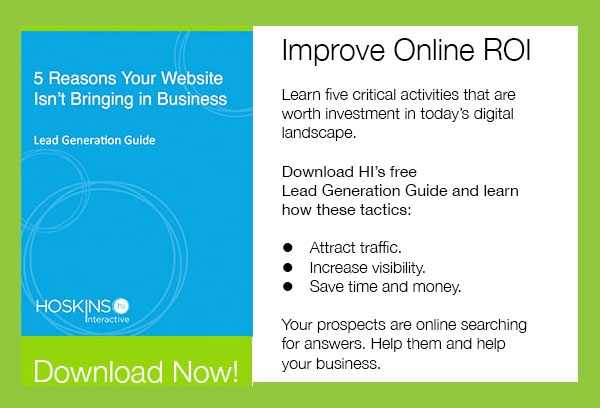Hoskins Interactive Media & Marketing Blog
Current Articles Rss FeedImprove Online Marketing Results: Think Like Your Customer
Posted bywpbizMon, Dec 2, 2013 @ 12:52 pm
Something just isn’t right. You may be blogging, active on social media, publishing content to showcase products and services…but you aren’t acquiring new customers and you’re not hitting revenue goals. Why? Most likely, you’re not in tune with the way your audience researches, thinks and makes purchase decisions.
Most people don’t wake up and decide to buy a house. And they typically don’t decide to buy your product or service the first time they visit your website; it’s a process that takes involves twists and turns. That’s why we set up conversion points—educational content offers that require different degrees of engagement and commitment from visitors. If a person doesn’t have enough information to name their problem, it isn’t likely that they’d spend an hour participating on a webinar.
When set up properly, content offers create an online sales funnel, a structure that facilitates sales. But the structure alone doesn’t help you convert more leads. Getting in your customers’ heads and producing the answers they seek is the key to generating more leads and sales online. The message you send matters. A lot.
The Buyer’s Journey: The Way Your Customer Thinks and Researches Before Purchasing
Your buyer generally flows through a three-stage thought process, which involves online research, before making a purchase:
- Awareness: the person is experiencing symptoms of a problem, but they haven’t identified the name of the problem yet. Example: discomfort in foot or knee after running or walking long distances.
- Considering: the person explores ways to fix the problem. With research, they are able to name the symptoms. Example: it could be due to pronation, repetitive stress injury, worn out shoes, running on concrete or difficult surfaces. The person think about options like: visiting a doctor, R.I.C.E., using a brace, ibuprofen or other medication, evaluating wear on running shoes/getting fitted for new shoes, cross train.
- Decision: the person pursues vendors and products to fix the problem; they find the specific orthopedist, or running shoe brand/store, pain reliever brand to relieve the pain.
Given this example, it’s easy to see how a show manufacturer could actively engage potential customers; by focusing on the problems and symptoms solvable by a running shoe brand. Publishing general information about issues—not your product—will win greater favor. That’s what users are consumed by—understanding their situation.
“Fifty-seven percent of a typical purchase decision is made before a customer even talks to a supplier.”– Why Solution Selling No Longer Works, Conference Executive Board (CEB).
Most companies are focused on engaging potential customers in the decision stage, when website visitors request a quote or other interaction with sales reps. But what about the people who don’t know they need your help? Framing your knowledge in context of the buyer’s journey helps you reel in leads earlier and guide decision making.
It’s a subtler way to sell your services, but one that works because it plays into how people use the Internet to make purchase decisions. How can you help them?
_________________________________________________________________________________
Terra Hoskins helps small and midsize businesses use their Web presence to grow; she coaches and consults on inbound strategies so that clients reach business goals, increase sales and share information effectively. She tweets at @terrahoskins.
* Photo by FutUndBeidl

